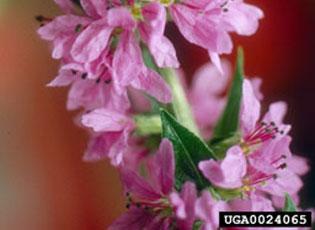Lythrum salicaria L. (ITIS)
Purple loosestrife, spiked loosestrife
Eurasia (Munger 2002)
Exact date unknown; was established by the 1830s (Munger 2002)
Through ships' ballast and as an ornamental (Munger 2002)
Crowds out native species (Munger 2002)

Purple loosestrife, flower
Photo by Norman E. Rees; USDA, Agricultural Research Service
Find more images
Distribution / Maps / Survey Status
All Resources
Selected Resources
The section below contains highly relevant resources for this species, organized by source.
Council or Task Force
Partnership
Federal Government
State and Local Government
Academic
Integrated Taxonomic Information System. Lythrum salicaria. [Accessed Sep 21, 2023].
Munger, G.T. 2002. Lythrum salicaria. In: Fire Effects Information System. U.S. Department of Agriculture, Forest Service, Rocky Mountain Research Station, Fire Sciences Laboratory.
